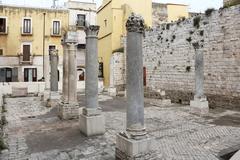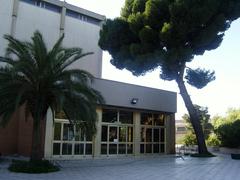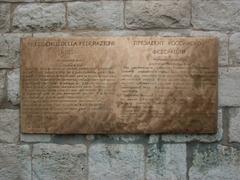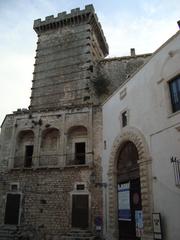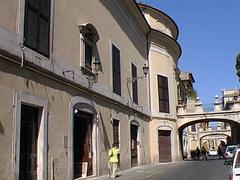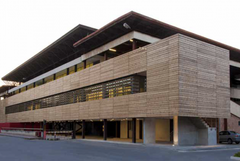
Santa Maria del Buonconsiglio: Visiting Hours, Tickets, and Historical Insights in Bari
Date: 14/06/2025
Introduction
Santa Maria del Buonconsiglio, nestled in the heart of Bari Vecchia, is a compelling open-air archaeological site offering a unique window into the city’s Byzantine and medieval heritage. Dating back to the 9th or 10th century, this evocative site embodies Bari’s transformation through Byzantine, Lombard, and Norman influences. Despite the loss of its original superstructure in the 20th century, its surviving mosaic floors, Roman columns, and foundational layout offer tangible links to Bari’s religious and cultural evolution.
Accessible free of charge and open year-round, Santa Maria del Buonconsiglio is both a site of historical significance and living cultural resonance. This comprehensive guide provides you with in-depth historical context, architectural highlights, cultural relevance, practical visitor information, and travel recommendations—ensuring a memorable and informed visit to one of Bari’s most intriguing historical sites (PugliaIn.net; BariExperience.com; Nomads Travel Guide).
Table of Contents
- Introduction
- Historical Origins and Architectural Features
- Historical Evolution and Transformations
- Cultural Significance and Symbolism
- Practical Visitor Information
- Frequently Asked Questions (FAQ)
- Conclusion
- References and Further Reading
Historical Origins and Architectural Features
Foundations and Byzantine Influence
Santa Maria del Buonconsiglio emerged during a pivotal era in Bari’s history. After the city was reabsorbed into the Byzantine Empire in the late 9th century, Bari became the capital of the Thema of Longobardia. The period was marked by the construction of numerous Marian churches, reflecting the Byzantine tradition of devotion to the Virgin Mary. The structure of Santa Maria del Buonconsiglio reflects this cultural and liturgical heritage, with archaeological evidence suggesting its completion between the late 9th and early 10th centuries (PugliaIn.net).
Architectural Layout and Details
The church was originally designed as a three-naved basilica, with two rows of columns dividing the naves. Key surviving features include:
- Roman Columns with Corinthian Capitals: These columns, likely repurposed from earlier Roman or Byzantine structures, provide a sense of the church’s scale and grandeur.
- Mosaic Floors: The tessellated pavement of the central nave, made of limestone and marble in geometric and floral motifs, is a highlight of the site and a testament to Byzantine artistic sensibilities (PugliaIn.net).
- Open-Air Foundation: The low perimeter walls and remaining pillars clearly outline the original layout, offering visitors an evocative sense of the church’s former grandeur.
Historical Evolution and Transformations
Medieval, Norman, and Later Periods
During the Byzantine period, many small churches—often private and associated with local families or ethnic communities—dotted Bari Vecchia. Santa Maria del Buonconsiglio, with its enduring structural core, survived through the Norman conquest in the late 11th century. While much of the Romanesque superstructure was lost in subsequent centuries due to neglect and urban redevelopment, the site’s essential layout and mosaic floors were preserved (PugliaIn.net).
Decline and Rediscovery
After centuries of religious and urban transformation, the church eventually fell into disuse and was largely demolished during 20th-century restoration campaigns. The ruins remained neglected for decades, suffering from vandalism and environmental exposure (Barinedita). Recent preservation efforts by local authorities and cultural groups have aimed to restore the site’s dignity, integrating it into Bari’s broader heritage routes, including those dedicated to Saint Nicholas (PugliaIn.net).
Cultural Significance and Symbolism
Spiritual and Social Importance
Santa Maria del Buonconsiglio is not only a historical monument but also a symbol of Bari’s resilient identity. Its dedication to the Virgin Mary reflects the city’s strong Marian devotion, a tradition rooted in Byzantine liturgy. The site’s mosaic motifs—checkerboards, diamonds, and floral designs—carry symbolic meanings of eternity and divine order, resonating with both religious and artistic traditions (Nomads Travel Guide).
Contemporary Community Engagement
Today, the site is a point of local pride and a focal point for discussions on heritage preservation and urban renewal. It is regularly included in guided walking tours of Bari Vecchia, helping to connect past and present and fostering a sense of community stewardship.
Practical Visitor Information
Visiting Hours and Tickets
- Opening Hours: The site is open-air and accessible at all times. For safety and optimal viewing, visit during daylight hours.
- Entry Fee: There is no entrance fee; access is free (Nomads Travel Guide).
Guided Tours and Accessibility
- Guided Tours: Offered by local operators, often as part of broader Bari Vecchia walking tours, providing rich historical context and legends.
- Self-Guided Visits: Free digital maps and apps are available to help navigate and understand the site.
- Accessibility: The terrain is uneven and may be challenging for visitors with limited mobility; wheelchair users may require assistance (Nomads Travel Guide).
Location and Getting There
- Address: Piazza Santa Maria del Buonconsiglio, Bari Vecchia, Bari, Italy.
- On Foot: Easily accessible from the Basilica di San Nicola (approx. 5-minute walk).
- Public Transport: From Bari Centrale train station, it’s a 20–25-minute walk or a short bus ride to the edge of Bari Vecchia, followed by a walk.
- By Car: Parking is available on the outskirts of the old town; driving within Bari Vecchia is not recommended (Nomads Travel Guide).
Best Time to Visit and Photography Tips
- Ideal Seasons: Spring (March–May) and autumn (September–November) for pleasant weather and fewer crowds.
- Best Lighting: Early morning or late afternoon for optimal photography of mosaics and architectural remnants.
Preservation and Responsible Tourism
- Respect the Site: Do not climb on ruins or disturb mosaic floors.
- Support Preservation: Participation in guided tours and cultural events helps fund restoration efforts.
- Responsible Behavior: Avoid littering or graffiti to help protect this vulnerable heritage site (PugliaIn.net).
Frequently Asked Questions (FAQ)
Q: What are the visiting hours of Santa Maria del Buonconsiglio?
A: The site is open to the public at all times, but visiting during daylight hours is advised.
Q: Is there an entrance fee or tickets required?
A: No, the site is free and does not require tickets.
Q: Are guided tours available?
A: Yes, many local operators include Santa Maria del Buonconsiglio in walking tours of Bari Vecchia.
Q: Is the site wheelchair accessible?
A: The area is uneven and may not be fully accessible; assistance is recommended for visitors with mobility needs.
Q: How do I get there?
A: The site is located in Bari Vecchia and is reachable by foot from major landmarks and by public transport from the city center.
Conclusion
Santa Maria del Buonconsiglio is a remarkable testament to Bari’s Byzantine and medieval heritage, offering a blend of architectural intrigue, spiritual resonance, and urban vibrancy. Its evocative ruins—Roman columns, mosaic floors, and open-air foundations—invite exploration and reflection, serving as both a window into the city’s past and a living symbol of its enduring spirit. Whether you are a history enthusiast or a casual traveler, a visit to Santa Maria del Buonconsiglio enriches any journey through Bari Vecchia.
To deepen your experience, consider combining your visit with nearby landmarks like the Basilica di San Nicola, Cattedrale di San Sabino, and Castello Normanno-Svevo. Download the Audiala app for guided tours and updates, and explore our website for more travel tips and cultural insights. Your visit helps preserve Bari’s irreplaceable historical treasures for future generations.
References and Further Reading
- PugliaIn.net
- BariExperience.com
- Nomads Travel Guide
- Barinedita
- BariExperience.com - English
- Nomads Travel Guide - Walking Tour
